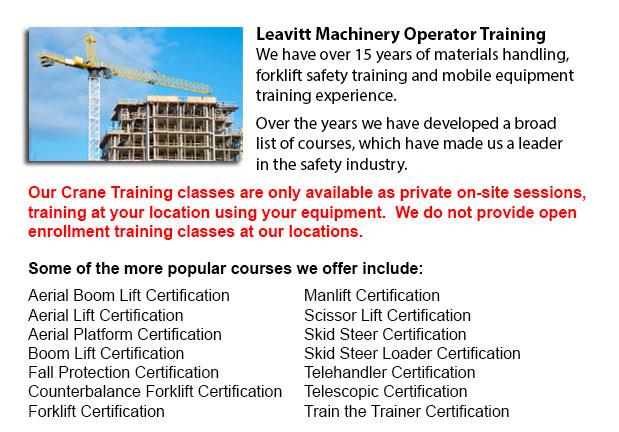
Sudbury Overhead Crane Operator Training - The course teaching overhead crane operator training has been designed specially to instruct trainees on the basics of pre-shift checks and overhead crane/sling operation. The programs are instructed by expert trainers and consultants. Well-trained workers are more productive and efficient, that saves on costs associated with property damage, product damage, and accidents because of the use of incorrect operating procedures. Our overhead crane certification is customized for staff who have literacy barriers, reducing certification time by 50 percent.
The overhead crane has been made to be used performing repetitive lifting activities. This type of crane can be utilized in various capacities. They may be utilized for specialized lifting tasks like for example installing or removing major plant machines.
In order to safely make use of an overhead crane, workers should employ safe rigging practices. This requires both knowledge and practice. The load must be rigged right to guarantee its stability when raised. Prior to beginning a hoisting task, it must be determined that the crane is right for the task, with right travel, lift and capacity. The crane should be subjected to a thorough visual and physical check before use. The capacity of all machinery, including the slings, hardware and rope, must never exceed load weight capacities.
Before using the rigger should know what sling is best for each lift and must check the rigging hardware and gear. The communications which are utilized with the crane operator should be concise and clear. A signaler should be chosen for the role and signals should be agreed upon. The operator of the crane should follow directions from the designated person only. If a wired or remote controller is being utilized, the operator must be trained in all its functions.
Prior to whatever lifting begins, the path of the load should be cleared of all obstructions and a warning sign should be issued to guarantee the safety of the staff. Pedestrian are not under any circumstance allowed to walk beneath the lift loads. The crane hoist has to be centered over the load prior to lifting to prevent swinging. The safety catch must be closed instantly after sliding the sling entirely onto the lifting hook. Sling legs that are not utilized should be secured so they do not drag. Never leave loose materials on a load being hoisted. Watch that fingers and hands are clear when slack is taken out of a sling. Before the lift is made, step clear of the danger zone.
-
Wheel and Track Loader Training in Sudbury
Lift trucks are obtainable in several different models that have different load capacities. The majority of average forklifts used in warehouse environment have load capacities of 1-5 tons. Bigger scale units are utilized for heavier loads, like for... More -
Sudbury Aerial Lift Certification
Sudbury Aerial Lift Certification - Aerial Lift Certification is for individuals who requires an in-depth understanding of aerial lift safety. Inspectors and operators, supervisors, maintenance workers and construction craftsmen must perform a traini... More -
Sudbury Forklift Certification Schools
Sudbury Forklift Certification Schools - Within North America, forklift certification is mandatory, making forklift training programs necessary for both the company and their employees working as forklift operators. Forklift training focuses on healt... More -
Sudbury Boom Lift Operator Training
Sudbury Boom Lift Operator Training - A cherry picker refers to a type of aerial work platform. Cherry pickers include a platform or bucket at the end of a hydraulic lifting system. The device is likewise called a man lift, boom lift, basket crane or... More -
Sudbury Telehandler Certification
Sudbury Telehandler Certification - Telehandler certification programs are both for operators who have some experience driving a standard forklift and for those with no experience. The real-world training offered by these courses produces graduates w... More -
Operator Safety Training, Re-Qualification Training, In-House Instructor Training in Sudbury
Lift trucks are utilized in just about all industrial construction sites and in warehouse operations and in boat yards. The reach feature of a lift truck is a vital component used in several applications like for example when a shelving system is bei... More -
Crane / Overhead Crane / Self-Erect Crane / Truck Mounted Crane / Hydraulic Cranes Training in Sudbury
Bridge cranes or overhead cranes are a type of industrial material handling crane making use of a line and hook apparatus which runs on a horizontal beam running along two widely separated rails. Lots of overhead cranes could be seen in a long factor... More -
Sudbury Forklift Safety Training
Sudbury Forklift Safety Training - Anyone who wants to operate a lift truck should take a forklift safety training course in order to become a certified forklift truck operator. There are a variety of ways to obtain forklift training. Programs are pr... More

Forklift Certification Sudbury
TOLL FREE: 1-888-254-6157
Sudbury, Ontario
forkliftcertificationsudbury.com
Email Us
About Us


